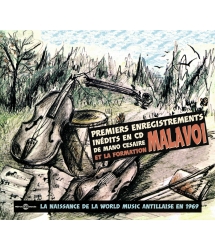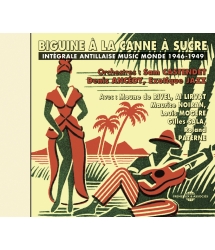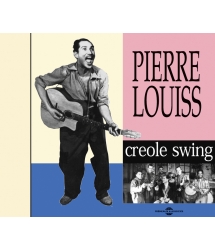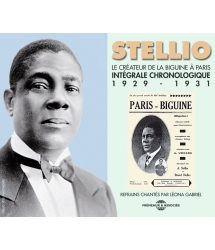FRENCH-CARIBBEAN MUSIC : AN INTRODUCTION
par latin american literature and arts
Like the tango, jazz and the rumba, the music of the French Caribbean territories – Martinique, Guadeloupe, and French Guyana – became all the rage in the Paris of the 1920s and 1930s. This was the golden age of the biguine, which developed out of the nineteenth-century French contredanses and quadrilles crossed with African-derived invention. Many clubs, especially in the Montparnasse area, featured musicians who made the journey from the carribbean and established their careers in Paris, recording for labels like Odéon and Pathé. The featured instrument was usually a clarinet, seconded by a violin, guitar, and/or saxophone, plus a rythm section, with the syncopated interplay found in New Orleans ensembles ; when they where lyrics, they wer sung in Creole. Indeed, some bands also played jazz in their repertoire and conversely, American performers like Josephine Baker and Sydney Bechet took an interest in their music as well.
par latin american literature and arts
Like the tango, jazz and the rumba, the music of the French Caribbean territories – Martinique, Guadeloupe, and French Guyana – became all the rage in the Paris of the 1920s and 1930s. This was the golden age of the biguine, which developed out of the nineteenth-century French contredanses and quadrilles crossed with African-derived invention. Many clubs, especially in the Montparnasse area, featured musicians who made the journey from the carribbean and established their careers in Paris, recording for labels like Odéon and Pathé. The featured instrument was usually a clarinet, seconded by a violin, guitar, and/or saxophone, plus a rythm section, with the syncopated interplay found in New Orleans ensembles ; when they where lyrics, they wer sung in Creole. Indeed, some bands also played jazz in their repertoire and conversely, American performers like Josephine Baker and Sydney Bechet took an interest in their music as well.
Thanks to the enterprising French label Frémeaux & Associés, which has specialized in reissuing recordings from that period (as it has with musette, tango, gypsy, and Brazillian music), most of the groups then popular can now be heard on two double-CD sets, Biguine, Valse et Mazurkas Créoles, which present many of the same musicians in Volume 1 (1929-1940) and Volume 2 (1930-1943). These include the clarinetists Alexandre Stellio and Eugène Delouche and the violonists Ernest Léardée and Roger Fanfant, all of them band-leaders. Part of what distinguished this music from other Carribean dance forms is the centrality of the melody as focused in the clarinet and also the use of the guitar, at least when played here by Pollo Malahel, a sound reminiscent of French Swing bands and the gypsy-guitar style typified by Django Reinhardt.
Stellio (1885-1939) was already the most prominent musician in his native Martinique, known for his authoritative and passionate style, before he and his band left for France in 1929. The double CD Stellio (Frémeaux) covers just his initial two years in Paris, where he was the ford to recored biguine – mostly his own compositions, rooted in the rich musical heritage of the city of Saint-Pierre (destroyed by a volcano in 1902). These sessions show the quick evolution of Stellio’s group sound, first with trombone, violin, abd cello ; later with piano, banjo, drums, and the sassy voice of Léona Gabriel. By 1931, during the five months in which he was a popular attraction at the ornate Pavillon de la Guadeloupe in the long awaited Exposition Coloniale Internationale, his band had expanded to include trombone and cello again, and the traditional chacha, a kind of shaker. I twas nearly the same band, in the last sessions here, with which he opened his own Paris club later that year.
With Stellio’s death and then the Nazi occupation of Paris, the popularity of the biguine went into decline, but after the Liberation, what became the most famous and longest-lasting West Indian cabaret opened, La Canne à Sucre. Most of the musicians who played there in those first years are to be found in Biguine à La Canne à Sucre 1946-1949 (Frémeaux), several who were active in Paris before the war : the clarinetist and Stellio disciple Maurice Noiran ; the bandleader Sam castendet, whose long residency at the club contributed to its renown ; and the delightful young singer Moune de Rivel, who continued her career in New York. The lilting music heard here carries on the infectious spirit of the earlier recordings, if a bit more polished, an dis not without its social commentary (as in « Martinique 48 », sung in French).
The musician who led the first house banda t La Canne à Sucre and quickly established himself throughout France and beyond, the guitarist and trumpeterer Pierre Louiss (1908-86) returned to live in his native Martinique only in the mid-1960s. More influenced by jazz and Rhythm & Blues than his predecessors, and with his smoky voice and jaunty tunes, he recalls the sound of Louis Prima, Creole-style. Indeed, on Creole Swing (Frémeaux), which gathers rare and unreleased recordings from the 1960s and 1970s, his original verve appears undimmed. Given the range of moods offered here, the music manages to be both intimate and expansive, showing why Pierre Louis sis long overdue for a revival.
In recent decades the music of Martinique and Guadeloupe has incorporated new elements ; the rhythmic density has increased under the influence of Cuban styles, calypso, and even funk. One of the most tireless innovators, Henri Guédon, Paris-based percussionist and singer, also an active painter, began in the 1960s to evolve a sort of salsa that draws on Cuban and jazz as well as Creole traditions, collaborating with many of the finest such musicians in his bands. On his two-CD Retrospective (Frémeaux), covering his work between 1972 and 1992, he even offers a pumped-up version of Stellio’s old hit « Sepen Maig ». Above all, in his weave of Old and New World currents, he reminds us how interconnected musical cultures can be.
The most popular style to emerge since the 1970s, in which Guédon was involved from the start, is known as zouk, créole slang for « party », marked by a driving high-tech sound rich in lead and backup vocals. […] other artists within the zouk landscape have sought to honor the polder Creole traditions more directly. One prominent group, Malavoi, incorporates biguines and mazurkas, and their string section may even break into passages, over a percolating rhythm, reminiscent of the French contredanses. […]
Jason Weiss is currently editing an anthology of the American writer Brion Gysin (University of California press) and teaching at The New School.
Jason WEISS
© LATIN AMERICAN LITERATURE AND ARTS














